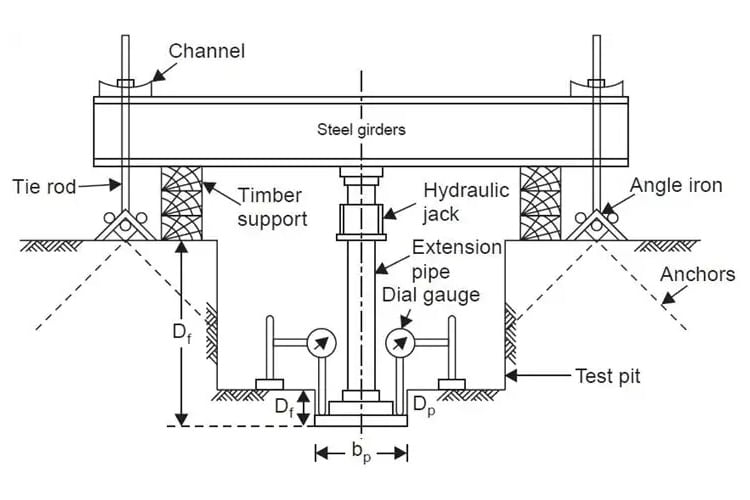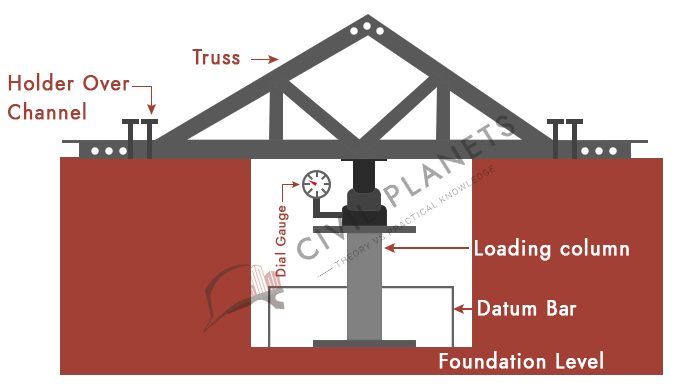The bearing capacity of the soil determines the type of foundation selection. The maximum capacity of the soil that supports the structural load without any shear failure or settlement is called the bearing capacity of the soil. It is calculated in load per unit area.
One of the tests that is performed to determine this value is known as Plate Load Test.

What is a plate load test?
The plate load test is used to determine the ultimate bearing capacity of the soil and the settlement of foundations of cohesionless soil. It is also known as the Plate bearing test.
There are other types of test used to determine the same such as
- Presumptive Analysis
- Analytical Methods
- Standard Penetration Test
- Modern Testing Methods
- Centrifuge Test
What is the purpose of plate load test?
- To identify how much load can be accommodated by the soil.
- To define what type of foundation has to be used on that soil-based on SBC.
How do you calculate SBC from a plate load test?
A square plate of 300mm x 300mm or a circular plate of 300mm diameter should be placed in the foundation at a certain depth. Then gradual load will be applied on the plate. Due to the pressure, the foundation settles down at each load increment.
Based on that settlement, the bearing capacity of the soil will be calculated.
The plate load test or plate bearing test should be performed as per the IS code 1888 either by gravity load test or reaction truss method.
Gravity load test
In gravity load tests, sandbags or concrete blocks are used as a dead load which is placed over the platform made by steel joists. A hydraulic jack is provided at an appropriate height to initiate the pressure between the vertical column and the steel plate.

Reaction Truss method
In here, the reaction truss will be installed replacing the concrete blocks or sandbags. The procedures are the same. With the help of hammers, the truss is controlled by soil anchors and nails fixed into the soil. The truss is made of mild steel sections.

The hydraulic jack bears the truss which is monitored by the dial gauge. The reaction generated on truss will be recorded on the gauge. To avoid the later movement, the truss is fastened by Guy-wire.
The equipment used for both tests is varied but the methodology and calculations to determine the ultimate bearing capacity is the same.
Apparatus Required

- Dial gauges (minimum 3)
- Plum Bob and spirit level
- Equipment for Excavation
- Hydraulic jack (50 T capacity)
- Column to transfer the load.
- Reaction truss or Gravity load material and other pieces of equipment for making loading platform
- Mild steel plate – 300mm x 300mm square plate or 300mm dia circular plate should have a minimum thickness of 25mm.
Precautions
- The alignment of the loading platform should be fixed accurately, and the plate should be positioned in the centre to the pit.
- The test should be stopped where the applied load reached 1.5 times of the safe load, or the settlement reaches 25mm.
Test Procedure
- Excavate the land at recommended foundation depth.
- The width of the pit should be greater than 5 times of the mild steel plate.
- Arrange and install the loading platform and ensure that there is no oscillation.
- Make a depression about 25mm center to the pit and embed the plate correctly.
- Now place a vertical steel column over the plate and place the hydraulic jack over the column.
- Fix the dial gauge at the bottom.
- Now apply a seating load about 70gm/cm2 to prevent undulation from happening beneath to the plate.
- Then apply the load about 7 Kn/Sqm and release it within a few seconds. Now apply the load again with an increment of 20% safe load with the help of hydraulic jack.
- Now record the settlement value at 1 min, 5min, 10min, 20min, 40min, and 60min and after that for every one-hour until the settlement reaches 25mm.
- The reading of 3 gauges calculates the average settlement.
In reaction truss loading method the load will be 2Kn/Sqm for every interval and the settlement has been recorded until the settlement rate reaches 0.2mm per hour.
Calculation of Bearing Capacity from Plate Load Test

- A graph has to be plot based on the observation; the load plotted on the X-axis and settlement plotted in Y-axis.
- The ultimate load can be obtained through the graph corresponding to the settlement load of 1/5th of the plate width.
- Based on the plotted points on the graph, the curve breaks at one point called the ultimate load on the plate.
- The ultimate bearing capacity, safe bearing capacity can be determined from the ultimate load on the plate.
- The ultimate bearing capacity is divided by 2 or 3 for the factor of safety to determine the safe bearing capacity.
Equations for calculating the bearing capacity and settlement of soil
Soil bearing capacity of clay soil
The equation to determine soil bearing capacity for clay
Ultimate bearing capacity = Ultimate load on Plate
Safe Bearing Capacity = Ultimate bearing capacity / Factor of Safety
The factor of safety = 2 or 3
Soil bearing capacity of Sandy Soil
The equation to determine soil bearing capacity for sandy soil

Settlement calculation of Clay Soil
The following formula can be used to determine the clayey soil from the plate load test.

Settlement calculation of Sandy Soil
The following formula can be used to determine the sandy soil from the plate load test.

The general formula for calculating the settlement of granular soil is,
Sf = Sp[Bf (Bp + 0.3)/Bp(Bf + 0.3)]²
For Clayey Soil is,
Sf = Sp*(B/Bp)
Sf = Settlement of footing in m
Sp = Settlement of plate in m
Bp = width of test plate in m
B = width of the footing in m
Advantages of plate load test
- Economical
- The methodology of plate load tests is simple.
- The tests help to understand the soil sustainability against a heavy load.
- Based on the results of the plate load test, the foundation can be designed either in a shallow or deep foundation.
Limitations of plate load test
- The test is not applicable for cohesive soil due to the test-taking a more extended period.
- The groundwater may affect the test result so the water should be pumped out from the pit.
- The soil layer must be uniform up to the desired foundation depth else the result may get an error.
- The test results show the immediate settlement of soil, and it is not applicable for longer time settlement.
Factors affecting bearing capacity
- Water level
- Shear strength
- Permeability
- Density of Soil
- The angle of internal friction
- Void ratio
Happy Learning 🙂
2 Comments
Thank you
Good.please send future articles related to caculation of structural stability soundnes
For the buildings
Thanking you
Er.R.Jayachandran